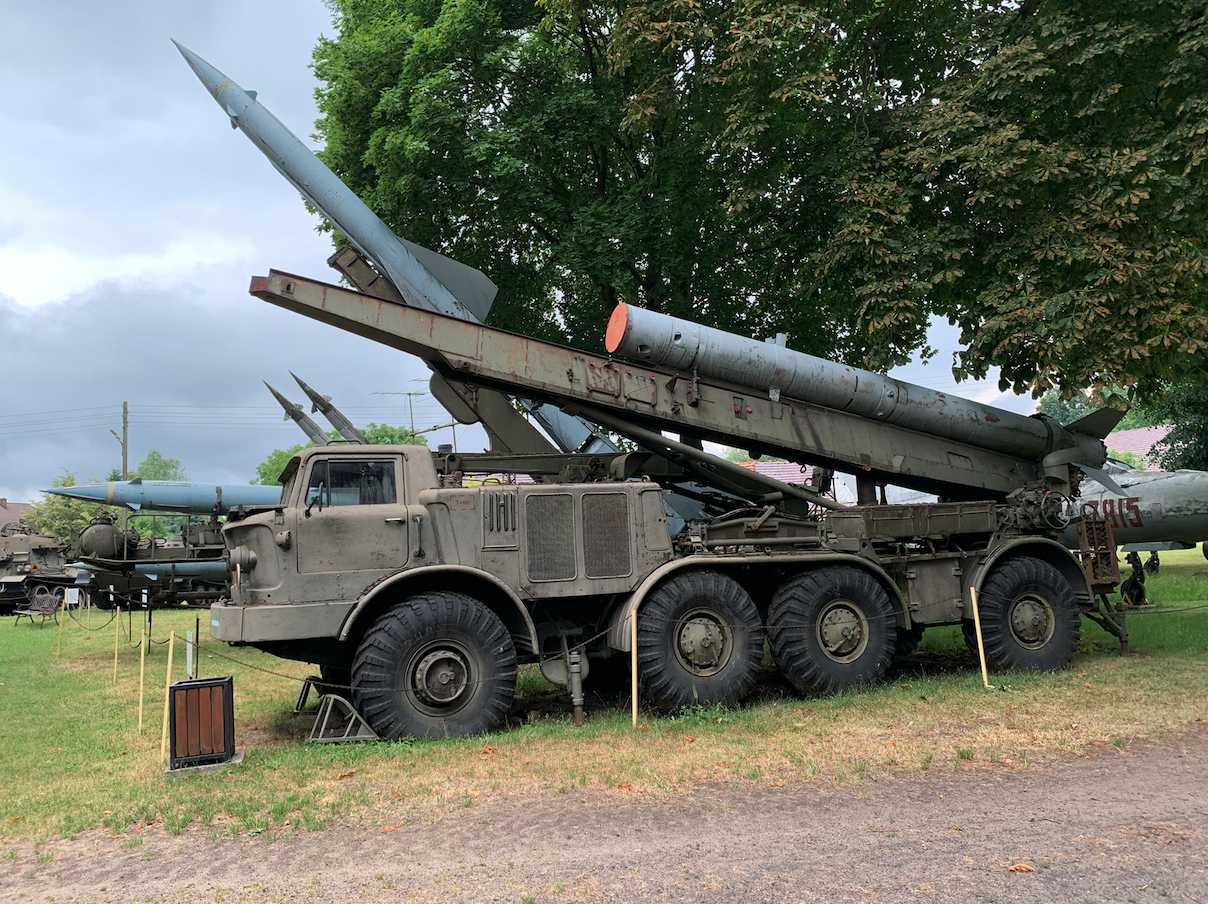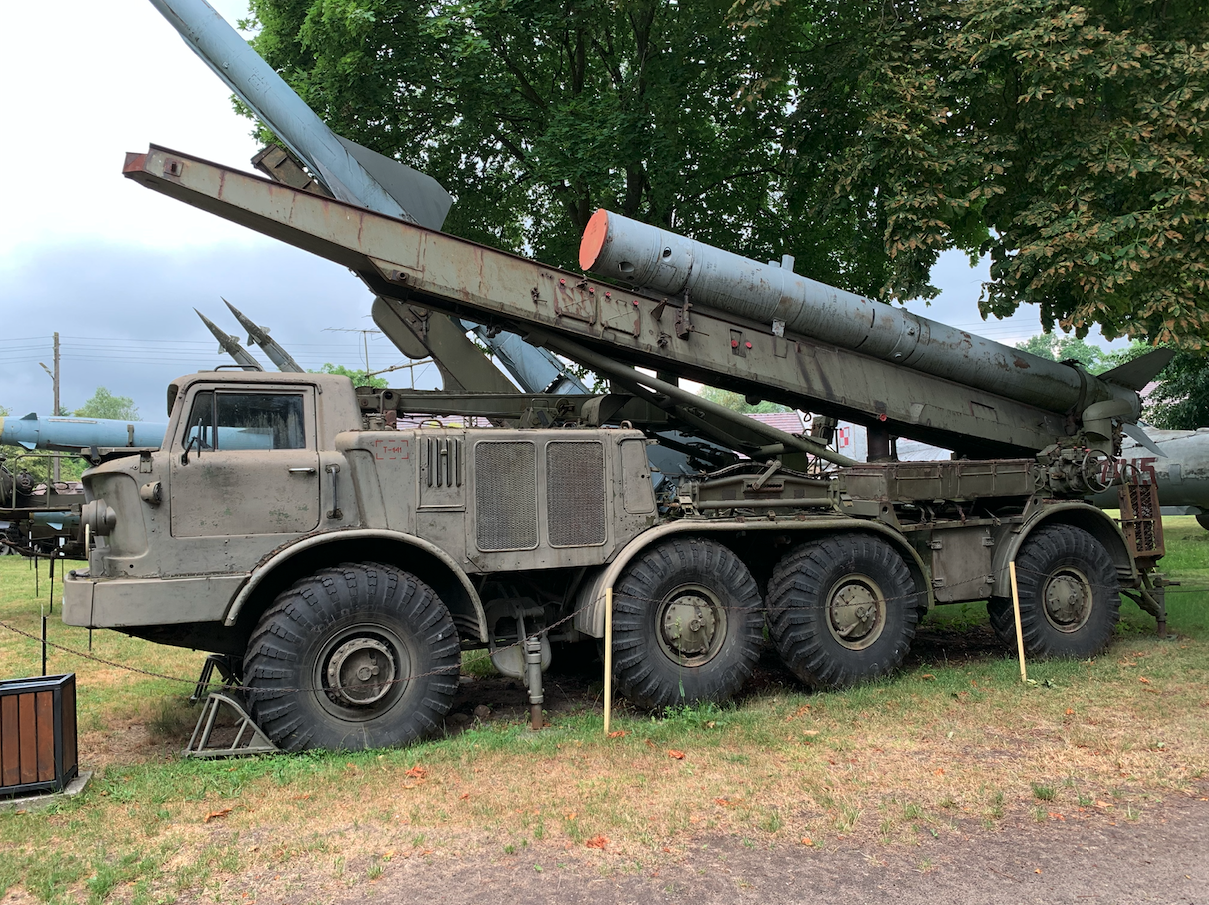Drzonów 2022-07-30
System rakietowy 9K52 Łuna-M.
Wyrzutnia pocisków rakietowych 9P113 Łuna.
W 60-latach XX wieku system rakietowy 9K52 wzbudzał uzasadniony strach wsród społeczeństw Europy. I to zarówno w krajach Europy Zachodniej, jak i w krajach Europy Środkowej, ponieważ te rakiety mogły być wyposażone w głowice jądrowe. Wówczas używano nazwy broń atomowa.
W 50/60-latach XX wieku sowieci opracowali kilka systemów rakietowych, o różnym zasięgu i przeznaczeniu. System 9K52 Łuna (Łuna-M) był systemem rakietowym krótkiego i średniego zasięgu. Podstawowy system klasy ziemia – ziemia był przeznaczony do wystrzeliwania pocisków rakietowych typu 9M21 z wyrzutni kołowych. Wyrzutnie kołowe otrzymały oznaczenie 9P113. Pocisk był jednostopniowym pociskiem rakietowym z silnikiem rakietowym na paliwo stałe, o zasięgu od 12 do 68 kilometrów, będącym w stanie przenieść głowicę bojową o masie do 500 kilogramów. Wsród tych głowic były głowice atomowe (jądrowe). Pierwszy start rakiety odbył się 27 grudnia 1961 roku, na poligonie Kapustin Jar. Powstało kilka wersji rozwojowych rakiety 9M21. Trzy były najważniejsze. Pierwsza to 9M21F, mająca głowicę kumulacyjno-burzącą o masie do 200 kg. Powstała także wersja 9M21B przenosząca pojedynczą głowicę jądrową o mocy do 100 kT. Kolejną wersją rozwojową był 9M21K, z głowicą kasetową. Układ rakietowy 9M21 był produkowany w Czelabińsku w Zakładzie Produkcji Obrabiarek.
Pierwsze prototypowe egzemplarze systemu weszły do służby już w 1962 roku, a oznaczone były 9K52 Łuna. Prawdopodobnie pełną gotowość do działania osiągnęły w 1964 roku.
Wyrzutnia 9P113 została oparta na doświadczeniach wyciągniętych z eksploatacji gąsienicowej wyrzutni 2P16. Podwoziem nowej wyrzutni stał się pojazd ZiŁ-135LM. Wyrzutnia była produkowana w Wołgogradzie przez Zakład Barykady (Баррикады) na podwoziu samochodu ZIŁ-135LM, produkowanego przez Briańską Fabrykę Samochodów.
System 9K52 Łuna-M został kupiony między innymi przez: Algierię, Egipt, Libię, Polskę, Rumunię, Węgry. System został użyty bojowo w wielu konfliktach zbrojnych w czasie „Zimnej Wojny”. Zawsze używano głowic z ładunkami konwencjonalnymi.
Wyrzutna posiada jednoszynową prowadnicę dla jednego pocisku. Dzięki podwoziu czteroosiowemu wyrzutnia 9P113 jest mobilna. Pocisk 9M21 jest balistyczny.
Wszystkie osie samochodu są napędzane. Pierwsza i czwarta oś jest skrętna. Pojazd posiadała dwa silniki benzynowe o mocy 180 KM każdy i dwie przekładnie. Z przodu znajduje się trzyosobowa kabina załogi. W kabinie są też zainstalowane pulpity służące do ustawiania i kontroli parametrów rakiet. Przed startem rakiety na przednie szyby kabiny nakładano osłony, w celu ich ochrony przed gazami prochowymi silnika rakiety. Startu dokonywano wyłącznie przy wykorzystaniu pulpitu wynośnego. Na pojeździe zamontowany jest zespół artyleryjski składający się z prowadnicy osadzonej na obrotowym łożu. Prowadnica może być podnoszona w płaszczyźnie pionowej od +15 do +65 stopni. Podnoszenie odbywało się za pomocą układu hydraulicznego – napędzanego elektrycznie lub ręcznie. Z prawej strony jest umieszczony dźwig hydrauliczny służący do przeładunku rakiet z samochodu transportowego na wyrzutnię. Dźwig ten służył też do montażu i demontażu głowic bojowych na podstawkach na ziemi. Pomiędzy dźwigiem a kabiną jest umieszczony bęben z elektrycznym kablem wielożyłowym, który służył do podłączenia pulpitu wynośnego. W lewej tylnej części wyrzutni jest stanowisko celowniczego wraz z przyrządami celowniczymi. Na stanowisku ogniowym wyrzutnia opierała się na czterech podstawkach. Dwie z nich były z tyłu podwozia, a dwie pomiędzy pierwszą a drugą osią pojazdu. Podstawki zapewniały stabilizację i wypoziomowanie wyrzutni. W wyrzutni był zamontowany dodatkowy agregat prądotwórczy, który służył do zasilania ogrzewania głowicy atomowej w czasie postoju. Resurs wyrzutni był obliczony na start co najmniej 200 rakiet. Czas przygotowania do odpalenie rakiety wynosił 10 minut.
Uzupełnieniem zestawu był pojazd transportowy 9T29 do przewozu dwóch rakiet 9M21. W pojeździe tym było kolejnych dwóch żołnierzy. Ten pojazd był zbudowany także na samochodzie ZiŁ-135. Kolejnym uzupełnieniem był samochód łączności radiowej. W skład zestawu wchodziły także: Stacja pogodowa, a zwłaszcza pomiaru kierunku i siły wiatru. Dane te były niezbędne dla przyrządów celowniczych. Konieczny był także pojazd autotopograf. Autotopograf jest to urządzenie mechaniczne zainstalowane w pojeździe mechanicznym służące do określania położenia (współrzędnych x, y) oraz określania kierunku poruszania się (azymutu). Urządzenie kreśli przebytą przez pojazd trasę na mapie topograficznej.
Dane T-T wyrzutni 9P113:
Długość 10,69 m. Szerokość 2,80 m. Wysokość z rakietą 3,35 m. Wysokość bez rakiety 2,86 m. Masa pojazdu bez rakiety 14 890 kg. Zasięg pojazdu z zabranym paliwem w dodatkowych kanistrach 650 km. Prędkość maksymalna 60 km/h na szosie. Pokonywanie przeszkód wodnych do głębokości 1,20 m.
Rakieta 9M21.
Rakieta 9M21 jest jednostopniowym, balistycznym, pociskiem na paliwo stałe. Składała się z głowicy i kadłuba zawierającego 3 silniki prochowe. W tylnej części rakiety znajdował się silnik startowy z 16 dyszami. W przedniej części kadłuba, był umieszczony silnik obrotu z 4 dyszami, ustawionymi poprzecznie do osi rakiety, nadający prędkość obrotową w pierwszej fazie lotu. Pozostałą część kadłuba zajmował silnik marszowy z dyszą centralną. Rakieta była stabilizowana w locie 4 statecznikami.
Rakieta 9M21B z głowicą atomową 9N32 z ładunkiem AA-22 o mocy od 3 do 20 kT. 9M21B1 głowica jądrowa 9N38 / 9N38M z ładunkiem АА-38, o mocy do 100 kT. 9M21B1 z głowicą jądrową 9N32М z ładunkiem АА-52 o mocy od 3 do 20 kT. Przy użyciu tych rakiet można było wywołać naziemny lub powietrzny wybuch jądrowy. Służyły do tego zapalniki zbliżeniowe, czujniki i radiowysokościomierze zainstalowane w głowicy. Głowice były wrażliwe na zmiany temperatury. Dlatego były przechowywane i przewożone w specjalnych samochodach-magazynach. Po połączeniu z układem rakietowym na głowice nakładano pokrowiec grzewczy zdejmowany tuż przed startem. Wymagana temperatura głowicy wynosiła 20-30 stopni Celsjusza.
Dane T-T rakiet 9M21:
Długość w zależności od użytej głowicy 8,96 m lub 9,40 m. Kaliber 544 mm. Rozpiętość wsteczników 1,70 m. Masa od 2 430 kg do 2 490 kg. Zasięg 12 – 64 km. Prędkość maksymalna około 1 200 m/s.
Opracował Karol Placha Hetman


